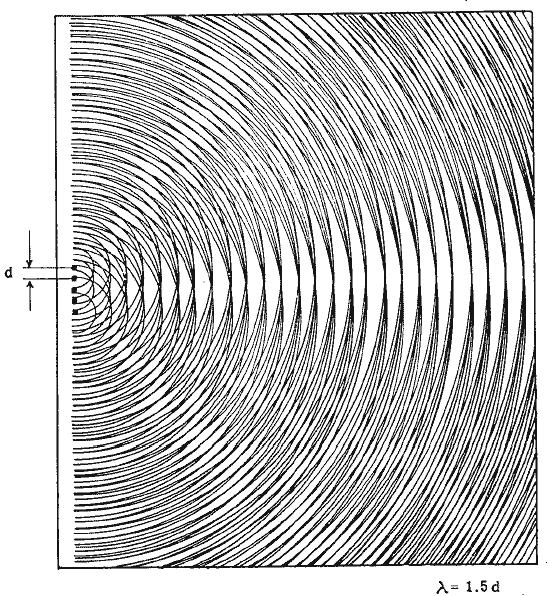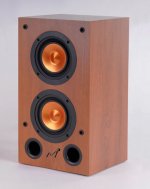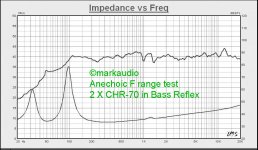there is a Wavecor that i find interesting, a Danish manufacturer building some of Scott's & my designs turned us on to it
I presume you mean SW182BD02? I was having a look at it the other day - looks like it'd take 2 per side to match an SDX7 or EX-Anarchy.
Wavne and Torrence,
I am surprised that no one has advised you on the down side of using 2 drivers in a fullrange design with all of the interference that results. If you look around you will notice that pretty much all good full reange designs use a single driver unless they are bi-poles. There is good reason for that...
Also, the cost of doubling up is going to open up driver choices that are twice the price. But generally speaking if you are interested in a full range design, using two is not as good as finding a single driver to do the job.
Another point that you may want to consider is that having power in your amp does NOT mean that you want to use it all if you don't have too. Find a driver that can EASILY provided the SPL that you desire without using up your amp.
I am surprised that no one has advised you on the down side of using 2 drivers in a fullrange design with all of the interference that results. If you look around you will notice that pretty much all good full reange designs use a single driver unless they are bi-poles. There is good reason for that...
Also, the cost of doubling up is going to open up driver choices that are twice the price. But generally speaking if you are interested in a full range design, using two is not as good as finding a single driver to do the job.
Another point that you may want to consider is that having power in your amp does NOT mean that you want to use it all if you don't have too. Find a driver that can EASILY provided the SPL that you desire without using up your amp.
mdikovics - Thanks for pointing that out. What are the downsides to using 2 drivers...what type of interference? I'm open to other suggestions for design & drivers.
In the meantime I am interested in what Dave has been working on. I'm sure he is also aware of the interference you refer to, maybe he has a workaround?
In the meantime I am interested in what Dave has been working on. I'm sure he is also aware of the interference you refer to, maybe he has a workaround?
What are the downsides to using 2 drivers...what type of interference?
In theory you get comb-filtering. In a chart/graph it really looks awful (more on that later).

2 drivers promise more dynamics, lower excursion (less doppler and other distortions), higher potential levels, more potential bottom end.
So people do it anyway. And report little downside. First one i recall was a set of dual Fostex FE167 (FE164?). He was cautioned of comb filtering (me amongst them), he had no problems. More have followed.
We were early advocates. With designs like Calhoun, Lotus^2, Coniston^2, and the microTowers (for example) we worked with variations on the bipole, in an effort to minimize or avoid the dreaded comb filtering, and the bipole dip. Each layout has its upsides & downsides.
Historically Ted Jordan was an early advocate of multiple front firing drivers, 4, 50mm units to be precise. The JxR6 is designed for this. Bandor ("Mrs Jordan" for those not familiar with the history) is too (a thread, with measures on a 4x50 array), Seventh Veil was a modern commercial version (7V was the owner, lots here on them) . Fostex has at least a few recommended designs with 2 front firing drivers. Audience is the most notable advocate using 4, 8, 16(?) 3".
An externally hosted image should be here but it was not working when we last tested it.
I was skeptical until Bob brought a set of 1 ft^3 PE curved cabinets with a pair of EL70 on the front to last summers diyFEST... and not mounted right together as minimum comb-filtering would suggest. They were very good.
With that as the pushing point we decided to start trying a few double front driver boxes out... the uFonken^2 work just fine. A number of Lake District boxes give the option of double front. The Mar-Kel^2 is another effort in this direction. One has the option of mounting the 2nd driver on the top castle-style, or even on the back.
Remember the charts? In Toole's recent landmark book he talks about comb-filtering quite a bit. The short version is your ear/brain expects comb-filtering. The charts look bad, but the ear/brain doesn't really care, comb-filtering has to be really severe to be a real issue.
dave
I presume you mean SW182BD02?
W182BD01, i figure "about the same" as 1 SDX7.
dave
In effect, yes. However, graphs are one thing, real life is another, and there is a lot of confusion on the subject. Key to remember is the fact that our ears and brains do not behave in the same way as a microphone & graphs. Roger Russell (ex head of design at McKintosh, & spent most of his life working with variations on arrays, so he knows what he's talking about) wrote this little piece in response to queries re his IDS25 array. I was one of the people who queried it actually. And then I tried it out for myself. Bluntly, he's right, for the most part. Why be so overly concerned about comb filtering in column speakers when you probably get this all the time with the speakers y The Haas effect does indeed kick in, and most FR drivers are beaming significantly as frequency increases, further reducing possible interference.
Speaking generally, I can't personally see any value in short arrays with very small drivers (< 3.5in or whatever); you might as well get one larger unit & have done with it. I'd only go down the array route with those if we're talking about 20 - 25 per channel, like Russell did, and lautsprechershop.de do with their TwentyFive array of (surprise... ;^) 25 drivers of similar size. However, with small units up to about 4.5in, you can often get away with a couple on the the same baffle, albeit with the penalty of a small sweet spot. Ideally you'd curve the baffle slightly too, but if you don't, providing you're not too far off axis, it's not going to cause women to pull their hair out or urchins to weep in the streets, and you'll get greater power handling, improved LF dynamic bandwidth, reduced distortion through several voice-coils etc. as compared to a single driver. Similar principles also operate for semi-omni designs with upward or sideways firing drivers, and bipoles. As it happens, from a combing POV, a bipole should be about the worst of the lot unless the rear driver is severely BW limited; how many times do you hear objections though? Almost never, because it's rare that anyone ever notices.
Given Mr. Dikovics' involvement with Jordan as a distributor of their drivers, I'm surprised that he should raise the subject TBH, given that several of their drivers (JXR6 HD & its predecessor) were designed with array-use in mind, as detailed on Ted's old site, the current EAD site, and his own Jordan-USA site in both the driver specifications and systems pages ('Jordan Linear Array' anyone?). Doreen Bance (ex. Mrs. Jordan) as noted also employed similar configurations in her speakers, as did the defunct Seventh Veil which employed her Bandor drivers.
Speaking generally, I can't personally see any value in short arrays with very small drivers (< 3.5in or whatever); you might as well get one larger unit & have done with it. I'd only go down the array route with those if we're talking about 20 - 25 per channel, like Russell did, and lautsprechershop.de do with their TwentyFive array of (surprise... ;^) 25 drivers of similar size. However, with small units up to about 4.5in, you can often get away with a couple on the the same baffle, albeit with the penalty of a small sweet spot. Ideally you'd curve the baffle slightly too, but if you don't, providing you're not too far off axis, it's not going to cause women to pull their hair out or urchins to weep in the streets, and you'll get greater power handling, improved LF dynamic bandwidth, reduced distortion through several voice-coils etc. as compared to a single driver. Similar principles also operate for semi-omni designs with upward or sideways firing drivers, and bipoles. As it happens, from a combing POV, a bipole should be about the worst of the lot unless the rear driver is severely BW limited; how many times do you hear objections though? Almost never, because it's rare that anyone ever notices.
Given Mr. Dikovics' involvement with Jordan as a distributor of their drivers, I'm surprised that he should raise the subject TBH, given that several of their drivers (JXR6 HD & its predecessor) were designed with array-use in mind, as detailed on Ted's old site, the current EAD site, and his own Jordan-USA site in both the driver specifications and systems pages ('Jordan Linear Array' anyone?). Doreen Bance (ex. Mrs. Jordan) as noted also employed similar configurations in her speakers, as did the defunct Seventh Veil which employed her Bandor drivers.
Last edited:
Wavne and Torrence,
Also, the cost of doubling up is going to open up driver choices that are twice the price. But generally speaking if you are interested in a full range design, using two is not as good as finding a single driver to do the job.
This was actually going to be my next question. Is there a more expensive 8-ohm ~90 dB full-range driver which is well suited to a small (8-10 liter) sealed or ported enclosure?
The Fostex FX120 is about on the money at 89dB 1m/1w & 7.3ohm (8ohm nominal) impedance. That's a lovely unit; not large, it's a 4 1/2in driver, with about 10in^2 pistonic CSA but 8 - 10 litres isn't much Vb to be working with, & in terms of physical size, pretty much rules out anything much larger. Fostex also have their F120a as well; similar sensitivity & impedance, & an AlNiCo motor. It's about double the price of the FX120 though, so as such, I always felt the FX was the canny choice, esp. as it's very close in performance terms & has a little more Xmax too.
Last edited:
The Fostex FX120 is about on the money at 89dB 1m/1w & 7.3ohm (8ohm nominal) impedance. That's a lovely unit; not large, it's a 4 1/2in driver, with about 10in^2 pistonic CSA but 8 - 10 litres isn't much Vb to be working with, & in terms of physical size, pretty much rules out anything much larger. Fostex also have their F120a as well; similar sensitivity & impedance, & an AlNiCo motor. It's about double the price of the FX120 though, so as such, I always felt the FX was the canny choice, esp. as it's very close in performance terms & has a little more Xmax too.
I've had opportunity to hear both the A & X in Fonkenesque enclosures - but not unfortunately able to directly compare them. I could easily live with either, but certainly agree that the lesser priced unit offers great value - maybe 90-95% of the performance for far less coin.
come to think of it, I could easily live with both, and for that matter multiples of several of Mark Fenlon's continually evolving line of metal and paper coned drivers
Last edited:
The Fostex FX120 is about on the money at 89dB 1m/1w & 7.3ohm (8ohm nominal) impedance. That's a lovely unit; not large, it's a 4 1/2in driver, with about 10in^2 pistonic CSA but 8 - 10 litres isn't much Vb to be working with, & in terms of physical size, pretty much rules out anything much larger.
I treat FX120 & F120A the same when it comes to boxes. Vented i wouldn't go less than 10 litre. Fonken-steen (20 l?) showed room for enven more Vb. I have an unbuilt design of 30 litres, the intention of which was to explore the limits.
89 dB is optimistic for these...
dave
Talking of twinning Markaudio drivers:
Here's the anechoic chamber test results from work I did for an Australian company early last year. The frequency response is well balanced for 2 X CHR-70 (from memory) in a 9 litre BR with twin ports. There's no filtering of anykind on this set-up.
What's interesting to note is the relative near flat response that doesn't show any significant variations in output compared to a previous single driver anechoic tests.
This measurement was taken at 1 metre distance from the cabinet. No differential and combing issues were evident on this and other tests we ran at the time.
Cheers
Mark.
Here's the anechoic chamber test results from work I did for an Australian company early last year. The frequency response is well balanced for 2 X CHR-70 (from memory) in a 9 litre BR with twin ports. There's no filtering of anykind on this set-up.
What's interesting to note is the relative near flat response that doesn't show any significant variations in output compared to a previous single driver anechoic tests.
This measurement was taken at 1 metre distance from the cabinet. No differential and combing issues were evident on this and other tests we ran at the time.
Cheers
Mark.
Attachments
Last edited:
- Status
- This old topic is closed. If you want to reopen this topic, contact a moderator using the "Report Post" button.
- Home
- Loudspeakers
- Full Range
- CHR/EL 70 cabinet decision

